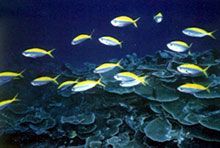Surin Islands, A beautiful family of islands in the calm Andaman Sea , is about 60 km. away from Kuraburi Seaport, Pang-Nga. From a total area of 135 SqrKm. , 102 SqrKm. or 76 % of Surin Islands is in the sea. There are 5 members in this family of islands ; North Surin Island ; South Surin Island ; Ree (Stork) Island : Middle (Bhajumba) Island; and Kai (Torinda) Island. These make up Thailands 29th National Park.

The most unblemished shallow sea corals can be found at Surin Islands. The tremendous amount of natural wealth here include MaeYaie Gulf where the most beautiful friging reef can be found near the shores. Thousands of years of underwater history created the gulfs coralline masterpiece of reindeer corals, gigantic coral rocks, and densely packed , thin dish-like corals.
Within the large diversity of life under water, dependent relationships are vital. One example is the relationship between the cute looking Clown Fish and beautiful seaflowers. They depend on each other to find food. Living around the seaflower, the Clown Fish attracts other fishes to come and be captured by the seaflower. The Clown Fish also gets a share of the food. The poisonous weapon used by the seaflower in killing their prey does not get through a protective slime convering the Clown Fishs skin.

Amazingly, there is little difference seeing in air and in water at Surin Islands. The water here is so clear that one can still easily see at least 15-20 meters around himself at 30 feet deep down.
The five islands are clustered together creating a large gulf. The geography here seems to block the winds all year round allowing beautiful coral reefs to form around every island. Moreover , the natural conditions here, Including the clean and clear sea water, the right temperature, all the necessary nutrients, chemicals and the rich amount of plankton , create the perfect environment for the development of coral reefs.

In 1991 , the Department of Fisheries reported that Mae Yaie Gulf has the most perfect corals in the Andaman Sea. Tragically, however, a close study by the marine biology department since then has found that Padina, a fast growing seaweed, has grown to cover over 5 SqrKm. of the once healthy corals . It has also grown out into Chong Kard Gulf and could extend the damage further to Surin Gulf.

The increase of the seaweed destroys the corals home, steals necessary nutrients from the water, and prevents sunlight from shining onto the corals, and hence indirectly kills the corals . Reluctant migrations are made by fishes, lobsters, crabs, and other marine animals for survival, while much have died long before. Consequently, in less than 7 years, Thailand most treasured coralline paradise transformed into an underwater graveyard.
When compared with the figure in the 1991 report from the Department of Fisheries , the amount of corals at Mae Yaie has decresed from 80 % to 10 % . This is clearly the result of the increase in the amount of the seaweed, Padina from 10 % to 80 % . This shocking figure can be explained by chemical reasons. The water from several samples has a high degree of Phosphate, a vital nutrient required by the seaweed. The important thing is that the large amount of Phosphate comes from dish-washing liquids , cleaning products and all sorts of other detergents. For a long time the chemical had built up in the sea resulting in the Deadly Seaweed problem.

Another main reason for this tragedy is the seashell business run by seaside people. A research in 1995 found that 58 kinds of shells and up to 1000 shells are sold in less than 2 hours. These are collected alive, killed and then sold to tourists as beautiful souvenirs.
Even though the National Park has now terminated all sales of shells , it has not actually solved the problem . It is impossible to instantly rescue the ecosystem because the reduced shell population could not keep up with the amount of the growing seaweed and they have already destroyed the balance.
It is evident that Thailand has really lost its most beautiful and perfect corals . And the problem has not stopped.
It is still growing , and within a few more years we would no longer see corals in Surin Island.